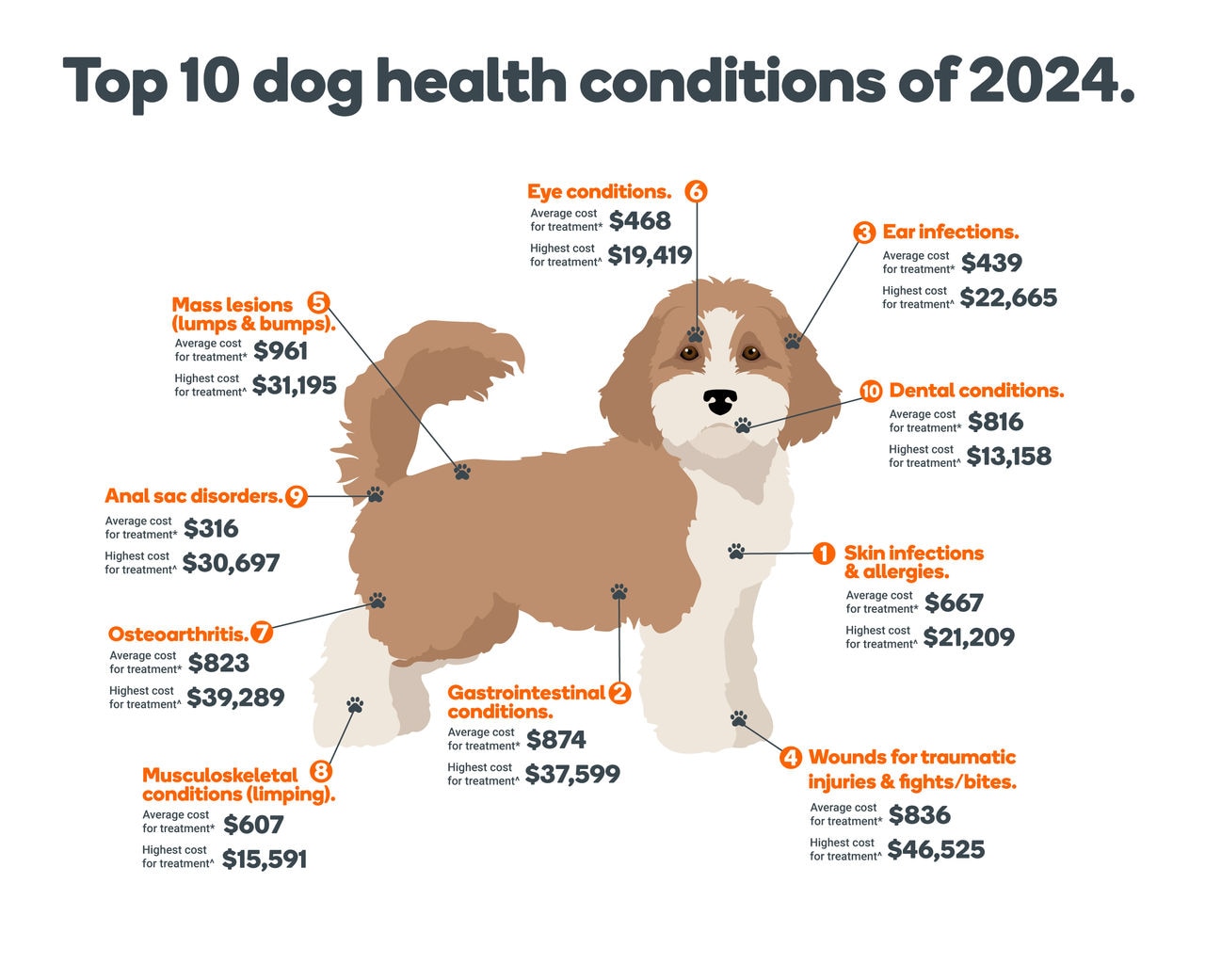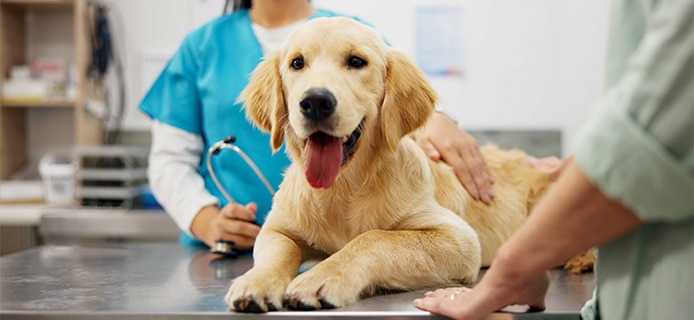- text
-
° This offer is only available for policyholders who have a registered Everyday Rewards Card linked to their eligible active Everyday Insurance policy. This offer is limited to one in-store Woolworths Supermarket transaction up to $500, with a maximum saving of $50 per Everyday Rewards Card, per month, regardless of the number of Woolworths services you use. For full T&Cs click here.
Top 10 common dog treatment costs.
Learn about the top common treatment costs for your dog.
Pet Insurance | 3 minute read | 11 June 2025

Owning a dog is one of life's greatest joys, bringing boundless love, laughter, and companionship into our homes. But alongside the wagging tails and sloppy kisses comes a significant responsibility: ensuring our beloved canine companions receive the best possible care, especially when it comes to their health. While we all hope our dogs stay happy and healthy throughout their lives, the reality is that veterinary visits could be an inevitable part of pet ownership.
In Australia, the cost of dog treatments can vary widely depending on the condition, the required procedure, and even your location. From routine vaccinations and preventative care to unexpected emergencies and chronic illness management, understanding the potential financial outlays is crucial for every responsible pet parent.
To help you navigate the financial side of pet ownership, we've compiled the top 10 dog health conditions of 2024, based on .

Note: pets may suffer from multiple conditions in a single year.
* Based on 2024 PetSure claims data as at Feb 2025. Amount claimed per policy over a 12-month period. Reimbursement for these claims under a pet insurance policy would be subject to limits, such as annual benefit limits or sub-limits, benefit percentage, applicable waiting periods and any applicable excess. Cover is subject to the policy terms and conditions.
^ Pet insurance policies can have an annual limit between $5,000 - $30,000 to assist with eligible treatment costs.
You should consider the relevant Product Disclosure Statement or policy wording available from the relevant provider. Please note that values calculated are based on all claims for that condition and medically-related conditions in each calendar year.
| Top 10 common illnesses/accidents. | Average cost for treatment.* | Highest cost for treatment.^ |
|---|---|---|
| 1. Skin infections & allergies. | $667 | $21,209 |
| 2. Gastrointestinal conditions. | $874 | $37,599 |
| 3. Ear infections. | $439 | $22,665 |
| 4. Wounds for traumatic injuries & fights/bites. | $836 | $46,525 |
| 5. Mass lesions (lumps & bumps). | $961 | $31,195 |
| 6. Eye conditions. | $468 | $19,419 |
| 7. Osteoarthritis. | $823 | $39,289 |
| 8. Muscoskeletal conditions (limping). | $607 | $15,591 |
| 9. Anal sac disorders. | $316 | $39,697 |
| 10. Dental conditions. | $816 | $13,158 |
Note: pets may suffer from multiple conditions in a single year.
* Based on 2024 PetSure claims data as at Feb 2025. Amount claimed per policy over a 12-month period. Reimbursement for these claims under a pet insurance policy would be subject to limits, such as annual benefit limits or sub-limits, benefit percentage, applicable waiting periods and any applicable excess. Cover is subject to the policy terms and conditions.
^ Pet insurance policies can have an annual limit between $5,000 - $30,000 to assist with eligible treatment costs.
1. Skin infections & allergies.
This broad category encompasses a wide range of dermatological issues. Allergies (food, environmental, flea), bacterial infections (pyoderma), fungal infections (ringworm, yeast), and various other skin irritations fall under this heading. It's a common health problem because dogs' skin is their largest organ and is constantly exposed to environmental allergens and potential pathogens. Certain breeds are also predisposed to allergies.
2. Gastrointestinal conditions.
This category includes a variety of digestive problems, such as vomiting, diarrhea, gastroenteritis, inflammatory bowel disease (IBD), and pancreatitis. Causes can range from dietary indiscretions to infections or underlying medical conditions. It's a common health problem because dogs are prone to dietary indiscretions (eating garbage, table scraps). Stress and infections can also disrupt their digestive systems.
3. Ear infections.
Ear infections (otitis externa, media, interna) are the most frequent ear problem in dogs. Other issues include ear mites, foreign bodies lodged in the ear canal, and hematomas. It's a common health problem because dogs' ear canals are L-shaped, which can trap moisture and debris, creating an ideal environment for infections. Floppy-eared breeds are particularly susceptible.
4. Wounds for traumatic injuries & fights/bites.
Injuries resulting from traumatic accidents, including puncture and laceration bite injuries, open and closed wounds and fractures of bones. It's usually common in active dogs, which are at a higher risk of accidents.
5. Mass lesions (lumps & bumps).
Mass lesions, commonly known as lumps and bumps, are frequent findings on and under a dog's skin. Other types of growths include cysts, warts, and abscesses. These are a common health concern because they can range from benign (harmless) fatty tumors called lipomas to more serious, malignant (cancerous) growths like mast cell tumors or fibrosarcomas. Any dog can develop lumps and bumps, but older dogs and certain breeds can be particularly susceptible to specific types of growths.
6. Eye conditions.
This category includes eye infections (conjunctivitis), corneal ulcers, cataracts, glaucoma, and other eye-related problems. It's a common health problem because dogs' eyes are vulnerable to injury and infection. Certain breeds are also predisposed to specific eye conditions.
7. Osteoarthritis.
Osteoarthritis (OA), also known as degenerative joint disease, is a common and debilitating condition in dogs, characterised by the progressive deterioration of cartilage in the joints. Other joint problems include hip and elbow dysplasia, patellar luxation, and ligament tears. It's a common health problem in dogs because genetics, conformation (e.g., large breeds), obesity, and previous joint injuries can all contribute to the development and progression of OA, leading to chronic pain and reduced mobility. Senior and large-breed dogs are particularly susceptible.
8. Muscoskeletal conditions (limping).
Joint problems, ligament tears, arthritis Intervertebral Disc Disease (IVDD) and other musculoskeletal issues are relatively common, particularly in older dogs, active dogs and certain breeds are predisposed to joint problems.
9. Anal sac disorders.
Anal sacs are small glands located on either side of the anus that secrete a foul-smelling fluid. Problems occur when the sacs become impacted or infected. It's a common health problem because some dogs have difficulty expressing their anal sacs naturally.
10. Dental conditions.
Dental conditions can be common in dogs, with periodontal disease (gum disease) being the most frequent oral health problem. Other issues can include broken teeth, abscesses, retained deciduous (baby) teeth, and oral tumours. It's a common health problem because plaque and tartar naturally build up on a dog's teeth, which can lead to inflammation, infection, and eventually, pain and tooth loss. Smaller breeds and those with crowded teeth can be particularly susceptible.
Above is a limited summary only based on .
Reimbursement for these claims under a pet insurance policy would be subject to limits, such as annual benefit limits or sub-limits, benefit percentage, applicable waiting periods and any applicable excess. Cover is subject to the policy terms and conditions. You should consider the relevant Product Disclosure Statement or policy wording available from the relevant provider.
How Everyday Pet Insurance can help.
Unexpected vet bills can be stressful. Pet Insurance can help cover the costs of diagnosis, treatment, and medication for various health conditions.
Here are some benefits you can enjoy with your Everyday Pet Insurance policy:
Other articles you might like.
Help protect your loyal companion with Everyday Insurance and get 10% off an in-store Woolworths shop every month°
* Based on 2024 PetSure claims data as at May 2025. Amount claimed per policy over a 12-month period. Reimbursement for these claims under a pet insurance policy would be subject to limits, such as annual benefit limits or sub-limits, benefit percentage, applicable waiting periods and any applicable excess. Cover is subject to the policy terms and conditions. You should consider the relevant Product Disclosure Statement or policy wording available from the relevant provider. Please note that values calculated are based on all claims for that condition and medically-related conditions in each calendar year.
^ Pet insurance policies can have an annual limit between $5,000 - $30,000 to assist with eligible treatment costs.
- text
-
† Offer available to new Everyday Pet Insurance policyholders, and is limited to 1 membership per eligible policy. The free membership offer (valued at $199p.a) is from the date of your policy commencement, provided your Everyday Pet Insurance policy remains active. You are not eligible to redeem the free membership subscription for cash or credit. VetAssist is a separate subscription based service to the Everyday Pet Insurance product, and is provided independently by Everyday Insurance third party service provider, VetChat Services Pty Ltd (VetChat). Click here for full VetAssist Service terms and conditions. Everyday Insurance reserves the right to vary or remove this offer at any time and will provide reasonable notice of any such changes.
- text
-
= The gap is defined as the difference between the vet's invoice and the claim benefit under your policy. Policy terms and conditions apply. GapOnly® is only available at participating Vets. Please visit GapOnly® to search for GapOnly® enabled vets. GapOnly® is a trademark owned by PetSure (Australia) Pty Ltd (PetSure) (ABN 95 075 949 923, AFSL 420183).
- text
-
** Offer is valid until 1 July 2026 (Offer Period). This entitles you to a 30% discount off your prescription medication purchase from PetScripts Pty Ltd ABN 73 610 444 427 (PetScripts) whilst your policy remains in force during the Offer Period and cannot be used in conjunction with any other offer. This offer only applies to medication prescribed to the pet insured under Everyday Pet Insurance Policies. Services provided by PetScripts are separate to your pet insurance policy. The 30% discount offer is subject to PetScripts' general Terms and Conditions, including the Privacy Policy which are available online at www.petscripts.com.au. Everyday Pet Insurance may withdraw or extend this offer at any time without notice.
- text
-
Everyday Pet Insurance policies entered into for the first time prior to 17 July 2023 and subsequent renewals of those policies are issued by The Hollard Insurance Company Pty Ltd ABN 78 090 584 473, AFSL 241436 (Hollard), arranged and administered by PetSure (Australia) Pty Ltd ABN 95 075 949 923, AFSL 420183 (PetSure) and promoted and distributed by Hollard’s Authorised Representative (AR) Woolworths Group Limited ABN 88 000 014 675, AR 245476 (Woolworths). Everyday Pet Insurance policies entered into for the first time on or after 17 July 2023 and subsequent renewals of those policies are issued by PetSure and promoted and distributed by PetSure’s AR, Woolworths. Any advice provided is general only and does not take into account your individual objectives, financial situation or needs. Please consider the Product Disclosure Statement (PDS) to ensure this product meets your needs before purchasing, or choosing to continue with the product. PDS and Target Market Determination available at insurance.everyday.com.au/pet-insurance.








